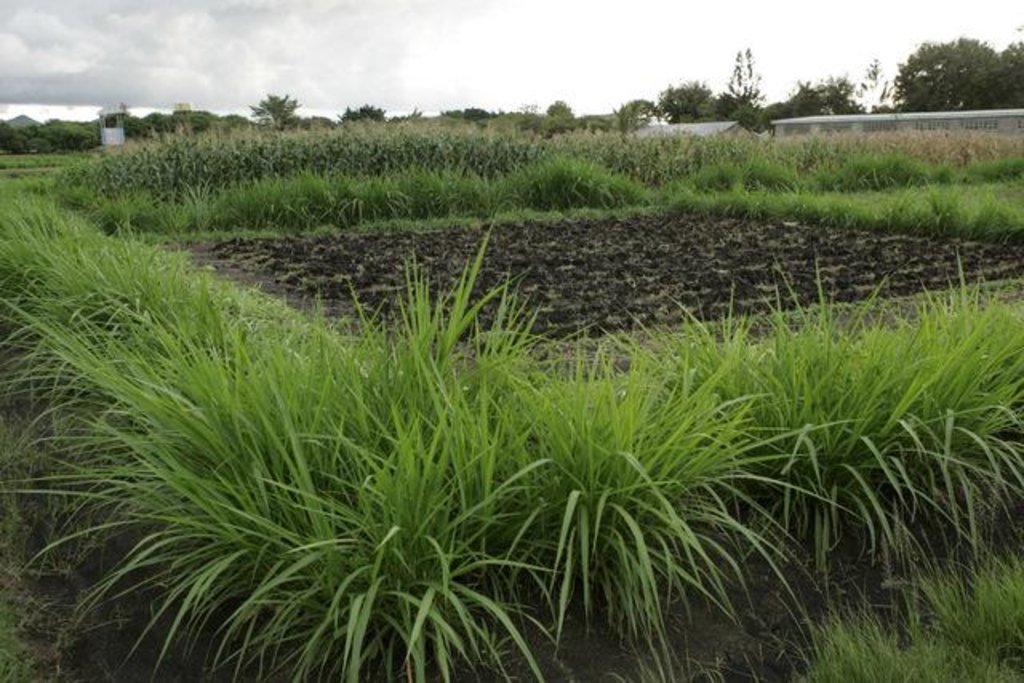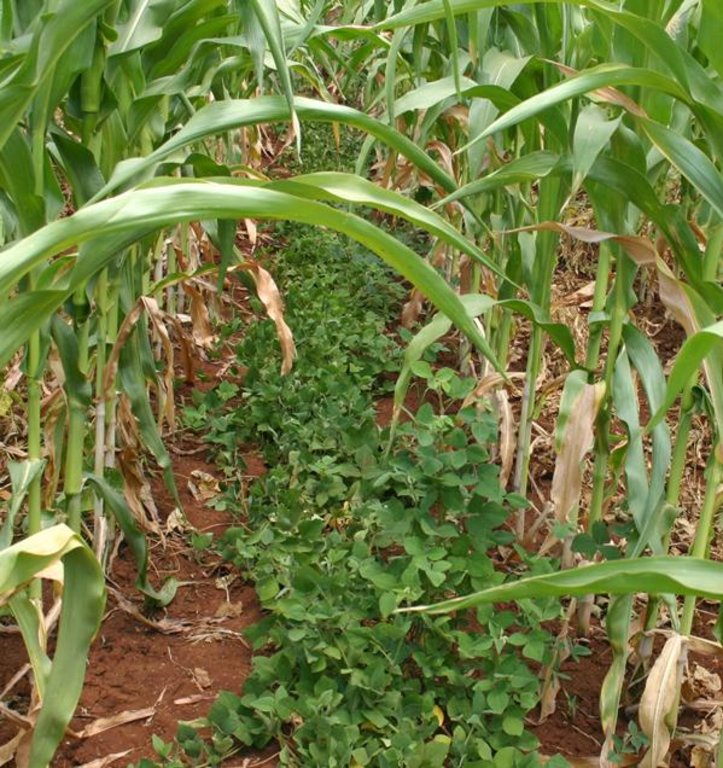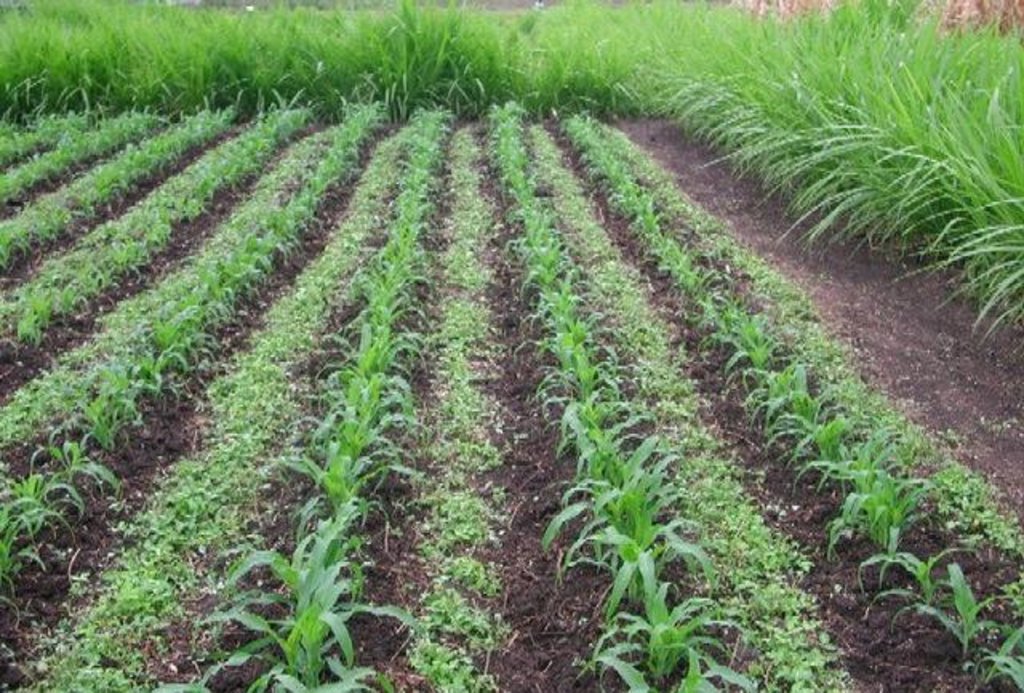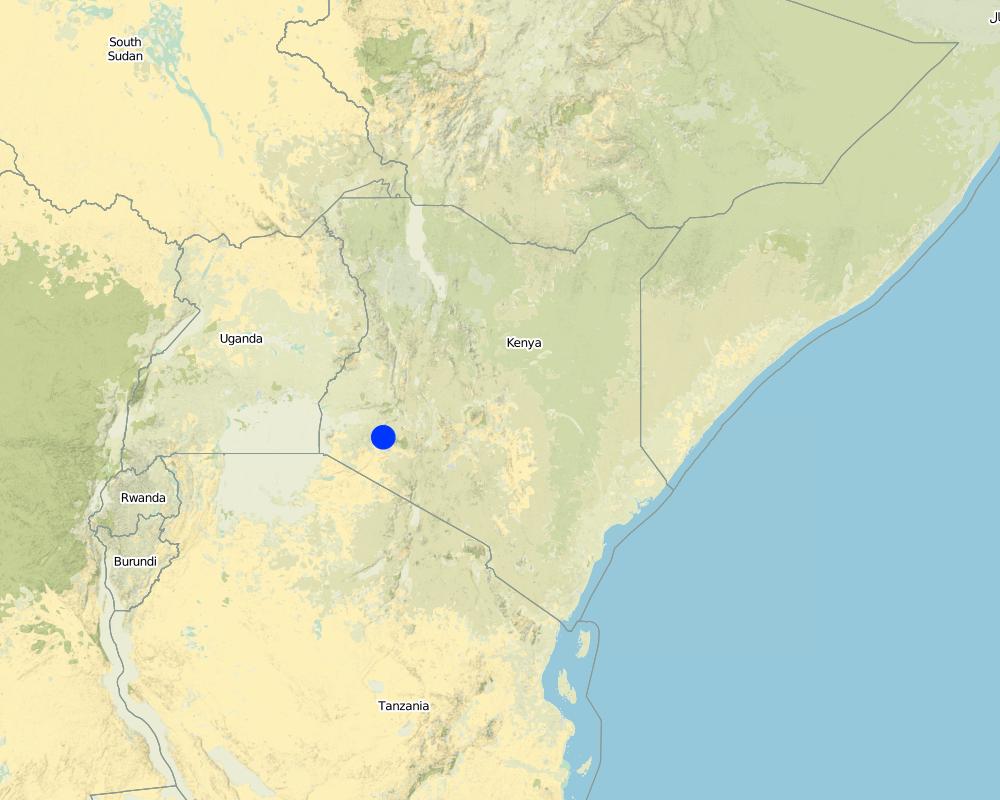Push-Pull Integrated Pest and Soil Fertility Management [كينيا]
- تاريخ الإنشاء:
- تحديث:
- جامع المعلومات: Unknown User
- المحرر: –
- المراجعون: David Streiff, Julie Zähringer
technologies_958 - كينيا
- Push-Pull Integrated Pest and Soil Fertility Management: 22 ديسمبر، 2016 (inactive)
- Push-Pull Integrated Pest and Soil Fertility Management: 28 مارس، 2017 (inactive)
- Push-Pull Integrated Pest and Soil Fertility Management: 12 مايو، 2017 (inactive)
- Push-Pull Integrated Pest and Soil Fertility Management: 25 إبريل، 2019 (public)
عرض الأقسام
توسيع الكل طي الكل1. معلومات عامة
1.2 تفاصيل الاتصال بالأشخاص الرئيسيين لمصدر المعلومات والمؤسسات المشاركة في تقييم وتوثيق التقنية
الشخص (الأشخاص) الرئيسي لمصدر المعلومات
متخصص في الإدارة المستدامة للأراضي:
Khan Zeyaur
zkhan@mbita.mimcom.net
International Centre of Insect Physiology & Ecology (ICIPE)
كينيا
متخصص في الإدارة المستدامة للأراضي:
Pittchar Jimmy
jpittchar@icipe.org
International Centre of Insect Physiology & Ecology (ICIPE)
كينيا
متخصص في الإدارة المستدامة للأراضي:
Wartmann Flurina
f.wartmann@biovision.ch
Biovision Foundation for ecological development
سويسرا
اسم المؤسسة (المؤسسات) التي سهلت توثيق/تقييم التقنية (إذا كان ذلك على صلة)
Biovision Foundation (Biovision Foundation) - سويسرااسم المؤسسة (المؤسسات) التي سهلت توثيق/تقييم التقنية (إذا كان ذلك على صلة)
International Centre of Insect Physiology & Ecology (ICIPE) - كينيا1.3 الشروط المتعلقة باستخدام البيانات الموثقة من خلال WOCAT
يوافق جامع المعلومات والشخص (لاشخاص) الرئيسي لمصدر المعلومات على الشروط المتعلقة باستخدام البيانات الموثقة من خلال WOCAT:
نعم
2. وصف تقنيةالإدارة المستدامي للأراضي
2.1 وصف مختصر للتقنية
تعريف التقنية:
“Push-Pull” is a technology to efficiently control pests and progressively improves soil fertility.
2.2 وصف تفصيلي للتقنية
الوصف:
In the Lake Victoria region - like in many other parts of sub-Saharan Africa – stemborer pests, striga weeds and poor soil fertility are the main constraints to efficient production of cereals. In combination they often lead to complete crop failure. The “Push-Pull” technology efficiently controls the pests and progressively improves soil fertility. It involves intercropping maize with a repellent plant, such as desmodium (“push”); an attractant trap plant, such as napier grass (Pennisetum purpureum) is planted as a border crop around this intercrop (“pull”). The stemborer moths are attracted to volatile compounds emitted by the napier grass which at the same time serves as a haven for the borers' natural enemies. When moths lay eggs on napier grass a sticky substance secreted by the grass physically traps the moths’ larvae. Napier is also an important carbohydrate-rich fodder grass. Desmodium, a perennial cover crop, produces repellent volatile chemicals that push away the moths, and the plant effectively suppresses striga weeds through its root exudates. Furthermore, desmodium fixes nitrogen, conserves soil moisture, enhances arthropod abundance and diversity and improves soil organic matter, thereby making cereal cropping systems more resilient and adaptable to climate change. Being a low-growing plant it does not interfere with the crops' growth. Push-pull simultaneously improves cereal productivity; enables production of year-round quality fodder - thereby allowing for integration with livestock husbandry; diversifies income streams and enables smallholders to enter into the cash economy. It also improves soil fertility; protects fragile soils from erosion and enables a minimum tillage system. The technology is appropriate to resource-poor smallholder farmers as it is based on locally available plants, affordable external inputs, and fits well with traditional mixed cropping systems practiced in SSA.
2.3 صور التقنية
2.5 البلد/المنطقة/المواقع التي تم تنفيذ التقنية فيها والتي يغطيها هذا التقييم
البلد:
كينيا
المنطقة/الولاية/المحافظة:
Lake Victoria region
Map
×2.6 تاريخ التنفيذ
في حالة عدم معرفة السنة بالتحديد، يرجى الإشارة إلى التاريخ التقريبي:
- منذ 10-50 سنة
2.7 إدخال التقنية
حدد كيف تم إدخال التقنية:
- أثناء التجارب/الأبحاث
3. تصنيف تقنية الإدارة المستدامي للأراضي
3.1 الغرض الرئيسي ( الأغراض الرئيسية) للتقنية
- التكيف مع تغير المناخ/الظواهر المتطرفة وآثارها
- خلق أثر اقتصادي مفيد
3.2 نوع (أنواع) استخدام الأراضي الحالية حيث يتم تطبيق التقنية

الأراضي الزراعية
- زراعة سنوية
- زراعة معمرة (غير خشبية)
المحاصيل الرئيسية (المحاصيل النقدية والغذائية):
Main cash crop (CA): Maiz
Others (CP): Desmodium (fodder)
التعليقات:
Major land use problems (land users’ perception): Cereal pests and diseases, decline of soil organic matter and fertility
3.3 مزيد من المعلومات حول استخدام الأراضي
إمدادات المياه للأرض التي يتم تنفيذ التقنية عليها:
- بعلية
3.4 مجموعةالإدارة المستدامة للأراضي التي تنتمي إليها هذه التقنية
- الإدارة المتكاملة لخصوبة التربة
- تحسين أصناف النباتات/سلالات الحيوانات
3.5 انتشار التقنية
التعليقات:
Total area covered by the SLM Technology is 76000 m2.
3.6 التدابير التقنية في مجال إلادارة المستدامة للأراضي

التدابير الزراعية
- A1: الغطاء النباتي/التربة

التدابير النباتية
- V2: الأعشاب والنباتات العشبية المعمرة
التعليقات:
Main measures: vegetative measures
Type of agronomic measures: mixed cropping / intercropping, contour planting / strip cropping, retaining more vegetation cover
Type of vegetative measures: aligned: -along boundary, aligned: -linear
3.7 الأنواع الرئيسية من تدهور الأراضي التي تناولتها التقنية

التدهور الكيميائي للتربة
- (Cn): تراجع الخصوبة وانخفاض محتوى المادة العضوية (غير ناتج عن الانجراف)

التدهور البيولوجي
- (Bh): فقدان الموائل
- (Bp): زيادة الآفات/الأمراض، وفقدان الحيوانات المفترسة
التعليقات:
Main type of degradation addressed: Cn: fertility decline and reduced organic matter content, Bh: loss of habitats, Bp: increase of pests / diseases, loss of predators
3.8 منع أو حد أو عكس تدهور الأراضي
تحديد هدف التقنية فيما يتعلق بتدهور الأراضي:
- منع تدهور الأراضي
- الحد من تدهور الأراضي
4. المواصفات الفنية، وأنشطة التنفيذ، والمدخلات، والتكاليف
4.1 الرسم الفني للتقنية
4.2 المواصفات الفنية/شروحات الرسم الفني
Layout of push-pull plot with1 m spacing between napier border and maize field
Technical knowledge required for field staff / advisors: moderate
Technical knowledge required for land users: low
Main technical functions: increase in organic matter, increase in nutrient availability (supply, recycling,…), promotion of vegetation species and varieties (quality, eg palatable fodder), pest control
Mixed cropping / intercropping
Material/ species: Desmodium as a perennial intercrop
Remarks: Desmodium is drilled in between maize rows at 75 cm row to row distance
Contour planting / strip cropping
Material/ species: napier grass (Pennisetum purpureum)
Remarks: Spacing of napier plants should be 75 cm between rows and 50 cm between plants within a row
Aligned: -along boundary
Vegetative material: G : grass
Spacing between rows / strips / blocks (m): 75.00
Vertical interval within rows / strips / blocks (m): 50.00
Aligned: -linear
Vegetative material: C : perennial crops
Spacing between rows / strips / blocks (m): 75.00
Perennial crops species: Desmodium
Grass species: Napier grass (Pennisetum purpureum)
4.3 معلومات عامة بخصوص حساب المدخلات والتكاليف
حدد العملة المستخدمة لحساب التكاليف:
- دولار أمريكي
اذكر متوسط تكلفة أجر العمالة المستأجرة في اليوم الواحد:
1.2
4.4 أنشطة التأسيس
| النشاط | نوع التدبير | التوقيت | |
|---|---|---|---|
| 1. | Plant 3 consecutive rows of napier grass (Bana variety) around the plot: make planting holes, apply fertilizer (or manure), place 3-node canes or root splits, cover with soil (before rains) | نباتية | |
| 2. | Land preparation for desmodium: plough and harrow the land (to get fine soil), make furrows between the rows where the maize will be planted (using strong pointed stick; before rains) | نباتية | |
| 3. | Mix desmodium seed with super phosphate fertilizer (ratio 1:2), or alternatively with fine soil. Sow into the furrows and cover with soil (onset of rains) | نباتية | |
| 4. | Plant maize./ Weeding of maize, desmodium and Napier grass | نباتية | 3 and 5-6 weeks after planting maize |
| 5. | Manage napier grass: 1st harvest after 3 months (plants are 1-1,5 m high), leave stem height of 10 cm for quick regrow, start with inner row | نباتية | 1st harvest after 3 months |
4.5 التكاليف والمدخلات اللازمة للتأسيس
| تحديد المدخلات | الوحدة | الكمية | التكاليف لكل وحدة | إجمالي التكاليف لكل مدخل | % من التكاليف التي يتحملها مستخدمو الأراضي | |
|---|---|---|---|---|---|---|
| العمالة | Plant 3 consecutive rows of napier grass | Persons/day | 8,0 | 1,25 | 10,0 | |
| المواد النباتية | Napier | pieces | 1200,0 | 0,1666666 | 200,0 | |
| المواد النباتية | Desmodium seeds | kg | 0,5 | 18,9 | 9,45 | |
| الأسمدة والمبيدات الحيوية | Fertilizer | kg | 47,0 | 0,6808 | 32,0 | |
| إجمالي تكاليف إنشاء التقنية | 251,45 | |||||
4.6 الصيانة/الأنشطة المتكررة
| النشاط | نوع التدبير | التوقيت/الوتيرة | |
|---|---|---|---|
| 1. | Land preparation for maize: carefully dig/plough between desmodium lines not to disturb / uproot the desmodium (it is a perennial crop!) | نباتية | |
| 2. | Plant maize | نباتية | |
| 3. | Trim the desmodium so that it does not overgrow in between the maize plants | نباتية | after 3 and 6 weeks |
| 4. | Repeat activities 5.-7. listed under establishment | نباتية |
4.7 التكاليف والمدخلات اللازمة للصيانة/للأنشطة المتكررة (سنويًا)
| تحديد المدخلات | الوحدة | الكمية | التكاليف لكل وحدة | إجمالي التكاليف لكل مدخل | % من التكاليف التي يتحملها مستخدمو الأراضي | |
|---|---|---|---|---|---|---|
| العمالة | Land preparation for maize | Persons/day | 6,0 | 1,166666 | 7,0 | 100,0 |
| الأسمدة والمبيدات الحيوية | Fertilizer for maiz | kg | 47,0 | 0,6808 | 32,0 | 100,0 |
| إجمالي تكاليف صيانة التقنية | 39,0 | |||||
التعليقات:
Machinery/ tools: planting stick / hoe
Size of push-pull plot for the cost calculations above = 0.25 ha.
4.8 أهم العوامل المؤثرة على التكاليف
قدم وصفا لأهم العوامل التي تؤثر على التكاليف:
Input prices (in US$):
1 Person-day = 1.2 US$.
1 napier root split / cane = 0.14 US$.;
1 kg desmodium seeds = 18.9 US$.;
1 kg superphosphate fertilizer = 0.68US$
5. البيئة الطبيعية والبشرية
5.1 المناخ
هطول الأمطار السنوي
- < 250 مم
- 251- 500 ملم
- 501 - 750ملم
- 1,000-751 ملم
- 1,500-1,100 ملم
- 2,000-1,500 ملم
- 3,000-2,001 ملم
- 4,000-3,100 ملم
- > 4000 ملم
المنطقة المناخية الزراعية
- شبه رطبة
Thermal climate class: tropics
Mainly sub-humid; bi-modal rainfall pattern, with main rainy season March-May; short rainy season Oct.-Nov.
5.2 طوبوغرافيا
متوسط الانحدارات:
- مسطح (0-2%)
- بسيط (3-5%)
- معتدل (6-10%)
- متدحرج (11-15%)
- تلال (16-30%)
- شديدة الانحدار(31-60%)
- فائقة الانحدار (>60%)
التضاريس:
- هضاب/سهول
- أثلام مرتفعة
- المنحدرات الجبلية
- منحدرات التلال
- منحدرات في السفوح
- قاع الوادي
المنطقة الارتفاعية:
- 100-0 متر فوق سطح البحر
- 500-101 متر فوق سطح البحر
- 1,000-501 متر فوق سطح البحر
- 1,500-1,001 متر فوق سطح البحر
- 2,000-1,501 متر فوق سطح البحر
- 2,500-2,100 متر فوق سطح البحر
- 3,000-2,501 متر فوق سطح البحر
- 4,000-3,001 متر فوق سطح البحر
- > 4000 متر فوق سطح البحر
التعليقات والمواصفات الإضافية بشأن التضاريس:
Slopes on average: Also flat (0-2%)
Landforms: Also plateau / plains
Altitudinal zone: 1200-1250 m.a.s.l.
5.3 التربة
متوسط عمق التربة:
- ضحل جدًا (0-20 سم)
- ضحلة (21-50 سم)
- متوسطة العمق (51-80 سم)
- عميقة (81-120 سم)
- عميقة جدًا (> 120 سم)
قوام التربة (التربة السطحية):
- متوسط ( طميي، سلتي)
- ناعم/ثقيل (طيني)
المواد العضوية في التربة السطحية:
- منخفضة (<1%)
إذا كان متاحًا، قم بإرفاق وصف كامل للتربة أو تحديد المعلومات المتوفرة، على سبيل المثال نوع التربة، الرقم الهيدروجيني/ درجة حموضة التربة، قدرة التبادل الكاتيوني، النيتروجين، الملوحة وما إلى ذلك.
Soil texture: Also coasre/light but texture is mostly loamy clay, partly sandy
Soil fertility is low
Soil drainage / infiltration is medium
5.6 خصائص مستخدمي الأراضي الذين يطبقون التقنية
التوجه السوقي لنظام الإنتاج:
- الكفاف (الإمداد الذاتي)
- مختلط (كفاف/ تجاري)
المستوى النسبي للثروة:
- ضعيف جدا
- ضعيف
أفراداً أو مجموعات:
- فرد/أسرة معيشية
مستوى المكننة:
- عمل يدوي
- الجر الحيواني
اذكر الخصائص الأخرى ذات الصلة لمستخدمي الأراضي:
Land users applying the Technology are mainly disadvantaged land users
Difference in the involvement of women and men: some organized in informal groups
Population density: > 500 persons/km2
Market orientation of production system: commercialization is just starting
5.7 متوسط مساحة الأرض المملوكة أو المستأجرة من قبل مستخدمي الأراضي الذين يطبقون التقنية
- < 0.5 هكتارا
- 0.5 - 1 هكتار
- 1 -2 هكتار
- 2 - 5 هكتار
- 5 - 15 هكتار
- 15 - 50 هكتار
- 50 - 100هكتار
- 500-100 هكتار
- 1,000-500 هكتار
- 10,000-1,000 هكتار
- > 10,000 هكتار
هل يعتبر هذا نطاقًا صغيرًا أو متوسطًا أو واسعا (في إشارة إلى السياق المحلي)؟:
- على نطاق صغير
التعليقات:
2ha, production area 0.9 ha
5.8 ملكية الأراضي، وحقوق استخدام الأراضي، وحقوق استخدام المياه
ملكية الارض:
- مجتمعي/قروي
- فردية، لا يوجد سند ملكية
التعليقات:
Land ownership: state, communal / village, individual, not titled, individual, titled
6. الآثار والتصريحات الختامية
6.1 الآثار التي أظهرتها التقنية في الموقع
الآثار الاجتماعية والاقتصادية
الإنتاج
إنتاج المحاصيل
التعليقات/ حدد:
Maize yields increase by 25-50% where stemborer is the only problem and by 300% in areas affected by stemborer and striga weed
إنتاج الأعلاف
التعليقات/ حدد:
All-year round quality fodder for cattle (napier grass and desmodium)
الدخل والتكاليف
النفقات على المدخلات الزراعية
التعليقات/ حدد:
Reduced fertilizer inputs thanks to nitrogen-fixing by desmodium
دخل المزرعة
التعليقات/ حدد:
Selling cereal grains, desmodium seed, napier grass (if not fed to own livestock), and milk
عبء العمل
التعليقات/ حدد:
Weeding is minimized
الآثار الاجتماعية والثقافية
Social capital generated through common learning and implementing agricultural “best practices”
الآثار الايكولوجية
التربة
رطوبة التربة
التعليقات/ حدد:
Cover crop, live mulch
غطاء التربة
التعليقات/ حدد:
Cover crop, live mulch
فقدان التربة
التعليقات/ حدد:
Soil protected from erosion through desmodium (cover crop) and napier grass (barrier)
دورة المغذيات/إعادة الشحن
المادة العضوية في التربة/تحت الطبقة c
الحد من مخاطر المناخ والكوارث
سرعة الرياح
التعليقات/ حدد:
Reduced wind impacts due to napier barriers
6.3 تعرض التقنية وحساسيتها لتغير المناخ التدريجي والظواهر المتطرفة/الكوارث المرتبطة بالمناخ (كما يراها مستخدمو الأراضي)
التعليقات:
Technology is tolerant to climatic extremes.
6.4 تحليل التكلفة والعائد
كيف يمكن مقارنة العوائد نسبة لتكاليف الإنشاء (من وجهة نظر مستخدمي الأراضي)؟
عوائد قصيرة الأجل:
إيجابي
عوائد طويلة الأجل:
ايجابي جدا
كيف تتم مقارنة العوائدمع كلفة الصيانة/التكاليف المتكررة (من وجهة نظر مستخدمي الأراضي)؟
عوائد قصيرة الأجل:
إيجابي
عوائد طويلة الأجل:
ايجابي جدا
6.5 اعتماد التقنية
من بين جميع الذين تبنوا التقنية، كم عدد الذين فعلوا ذلك بشكل تلقائي، أي دون تلقي أي حوافز مادية/مدفوعات؟:
- 10-0%
التعليقات:
100% of land user families have adopted the Technology without any external material support
There is a strong trend towards spontaneous adoption of the Technology
Comments on adoption trend: To date it has been adopted by over 29,000 smallholder farmers in East Africa, mostly without incentives. Where the technology is being introduced for the first time, farmers only need demonstration and technology information
6.7 نقاط القوة / المزايا / الفرص التي توفرها التقنية
| نقاط القوة/ المزايا/ الفرص من وجهة نظر جامع المعلومات أو غيره من الاشخاص الرئيسيين لمصدر المعلومات |
|---|
| Improves cereal productivity |
| Enables production of year-round quality fodder - thereby allowing for integration with livestock husbandry |
| Diversifies income streams and enables smallholders to enter into the cash economy |
| Improves soil fertility; protects fragile soils from erosion and enables a minimum tillage system |
| The technology is appropriate to resource-poor smallholder farmers as it is based on locally available plants, affordable external inputs, and fits well with traditional mixed cropping systems practiced in SSA. |
6.8 نقاط ضعف / مساوىء / مخاطر التقنية وسبل التغلب عليها
| نقاط الضعف/ المساوىء/ المخاطر من وجهة نظر مستخدم الأراضي | كيف يمكن التغلب عليها؟ |
|---|---|
| Napier grass is an aggressive plant that spreads through rhizomes under the ground | regular control and weeding. |
| The older napier stems and leaves are less palatable for livestock | regularly cut young, tender leaves and stems. |
| Minor adjustment of the smallholder farming system to introduce desmodium in traditional maize-bean intercrops | desmodium (fodder crop) and beans (food crop, important protein source) can both be intercropped with maize. In areas where striga weed is not a problem, farmers can plant desmodium after every 3 or 5 rows of maize, and use the other rows for beans. Stemborers will still be repelled |
7. المراجع والروابط
7.2 المراجع للمنشورات المتاحة
العنوان، المؤلف، السنة، النظام القياسي الدولي لترقيم الكتب ISBN:
Prof. Zeyaur R. Khan (Principal Scientist and Programme Leader) and Jimmy Pittchar, Push-pull Programme, International Centre of Insect Physiology & Ecology (ICIPE), Mbita Point, Kenya; zkhan@mbita.mimcom.net; jpittchar@mbita.mimcom.net; jpittchar@icipe.org
العنوان، المؤلف، السنة، النظام القياسي الدولي لترقيم الكتب ISBN:
Prof. Zeyaur R. Khan (Principal Scientist and Programme Leader) and Jimmy Pittchar, Push-pull Programme, International Centre of Insect Physiology & Ecology (ICIPE), Mbita Point, Kenya; zkhan@mbita.mimcom.net; jpittchar@mbita.mimcom.net; jpittchar@icipe.org
الروابط والوحدات المواضيعية
توسيع الكل طي الكلالروابط
لا يوجد روابط
الوحدات المواضيعية
لا يوجد وحدات مواضيعية







